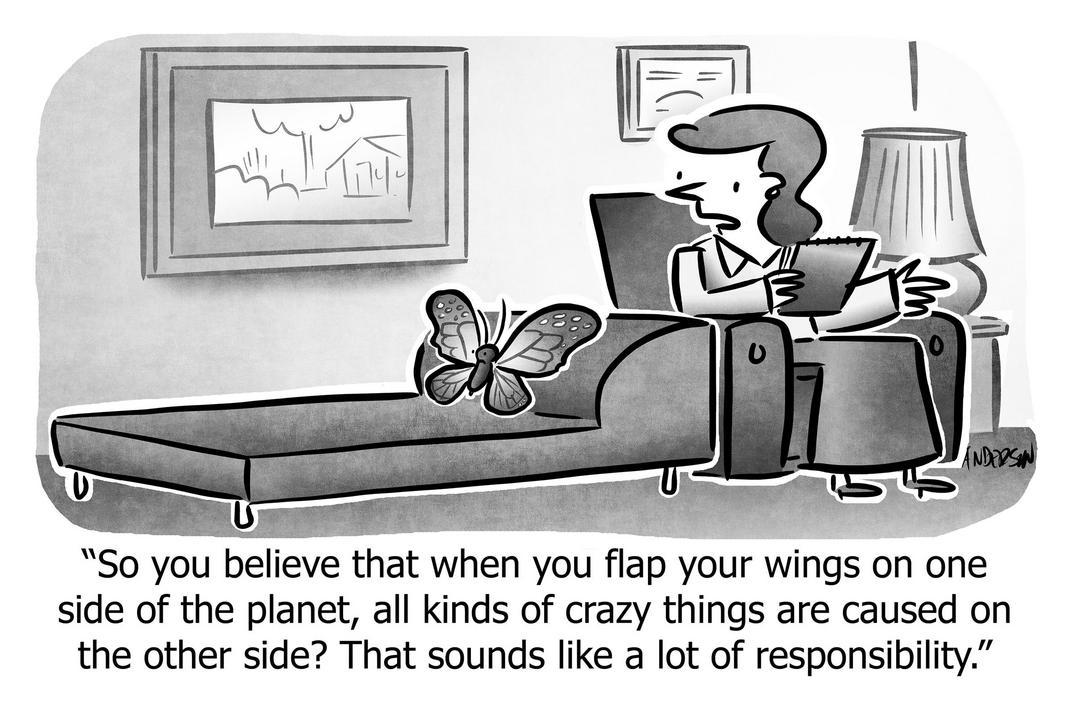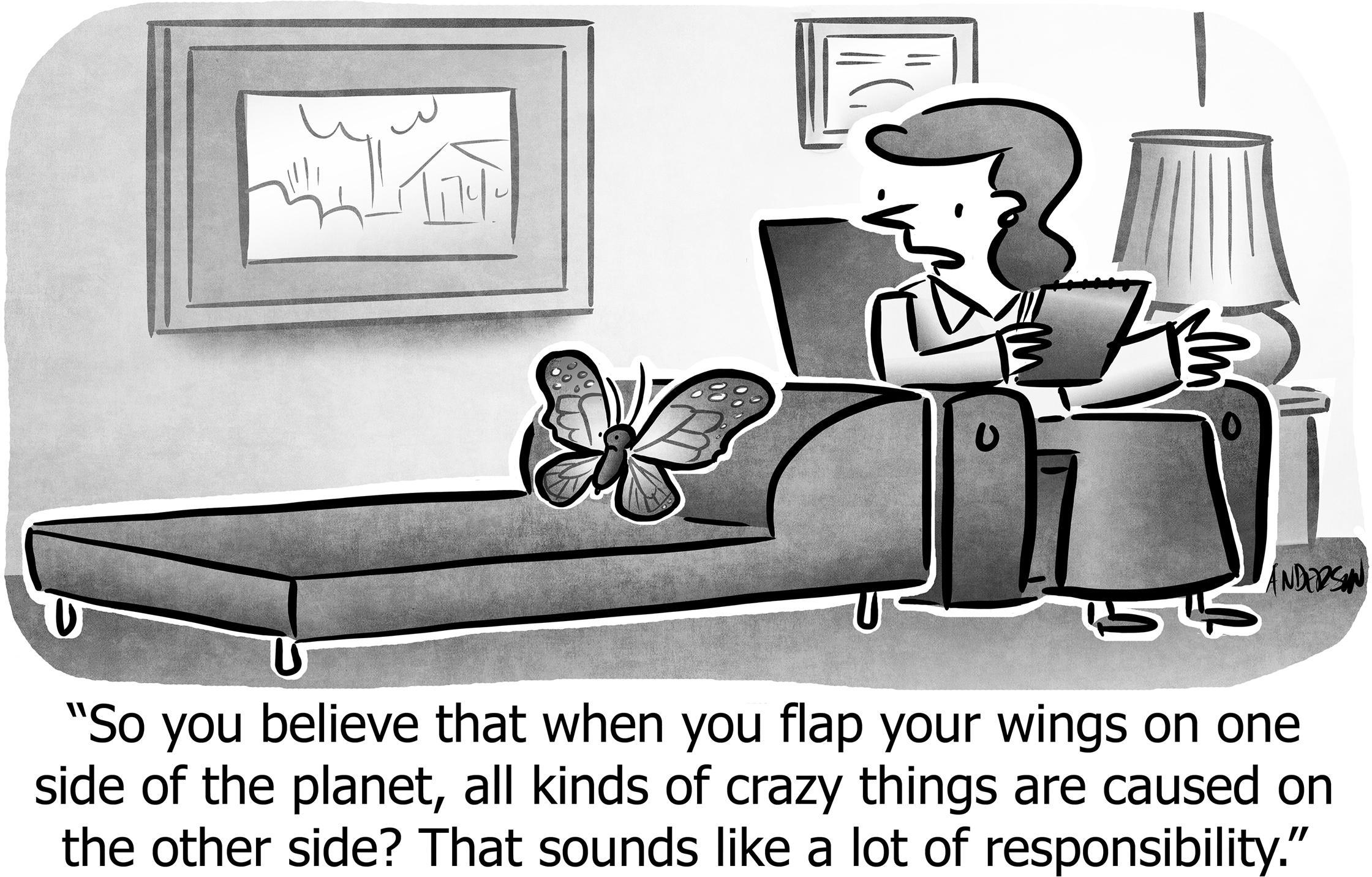A butterfly flaps its wings and you make a sale
It’s easy to be taken in by the idea of the Butterfly Effect: That a butterfly gently flapping its wings in the jungles of Madagascar eventually causes a Typhoon off the coast of Jakarta.
Or, updating for modern-day relevancy, Naomi Dunford pounds a curse word into a WordPress and Brian Clark makes $172. Or Dave McClure releases a silent-but-deadly outside a Menlo Park Starbucks and a social media company gets funded in Boston.
It’s a great story: Little actions can have enormous influence. A small favor you do on Twitter results in a viral post seven months later. A small change to your download page results in 20% more trials. A subtle shift in background color increases average time-on-site by 27 seconds.
Lorenz Attractor
We’re willing to believe it because mathematicians have shown that it is true for certain types of complex-yet-sensitive systems like weather and economics and fractals.
We want to be believe it because it’s harmonious and comforting to think that everything is connected—that the tiniest action has the potential for significant effect. It means every person has the power to change the world.
Even the smallest person can change the course of the future.
—The Fellowship of the Ring, J.R.R. Tolkien
For me the most compelling evidence comes from cognitive psychology where studies abound with astounding tales of subtle environmental changes radically and systematically affecting people’s behavior.1
1 Editor’s Note: 14 years after this was written, in 2024, most of these “results” have been debunked because they’re impossible to reproduce. This alone should cause us to be skeptical of their application in marketing, but read on for another reason, even for the (unknown) subset of them that are true.
It’s relevant for marketing and sales because it’s an inside scoop about how to manipulate strangers on the sly. It’s akin to subliminal messaging, but more pervasive, more powerful, and less susceptible to biting satire.
Eerie examples:
- Touching merchandise while you’re shopping increases the chance that you’ll purchase it. ( source)
- Students performed word-searches from random words. Some of the puzzles were seeded with words associated with old age, e.g. gray, wrinkle, bingo, Florida. While traversing a hallway after solving the puzzle, those students given “old” words walked more slowly. ( source)
- Students took a survey about health risks; half walked down a hallway where someone was sneezing. Those who passed the “ill” confederate reported a more negative view of the American health system and believed the average American was more likely to die of heart attack. ( source)
- Students were asked to recount memories while moving marbles between two trays. When moving marbles from a lower tray to a higher one, the memories were more positive; when moving downward the memories were more negative. ( source)

The Butterfly Effect
(Actually Rorschach, 1948)
This news should be simultaneously titillating for marketers (“Ooo, puppet strings!”) and frightening for consumers (Are you ever in control of your own decisions?).
But actually, when taken to its logical conclusion, you have to ignore it.
After all, these studies touch a tiny subset of the hailstorm of influences constantly befalling us. When I’m at the mall I’m passing people who are coughing just like the experimenter in the study… but also people who are angry, laughing, sitting, jogging, yelling, sleeping, shoplifting, and eating. Each storefront beckons me with colors, shapes, fonts, compositions, arrows, borders, lighting, and even sounds and smells.
All this is (apparently) tugging me in different directions, just below the veneer of consciousness where my impulsive, subconscious lizard brain is eagerly lapping up the stimuli and directing my attention and my wallet.
But then again, despite these impressive efforts, I’m distracted by the P.A. system blaring about a 6-year-old knee-deep in the fountain outside the Men’s Dillards. And then my cell phone goes off with a new tweet mentioning @asmartbear and my heart goes all aflutter (Ooo, attention! Please love me so I can love myself!). And then a butterfly flaps its wings (this time in Argentina) and suddenly and inexplicably I decide against the indulgence of a Double Doozie Cookie.
If I’m constantly influenced in all directions, the forces cancel each other out, and none of them matter.
It’s worse on the Internet. You’re competing not only with the real world but with the virtual world of tabbed browsing, Twitter alerts, back buttons, bouncing tray icons, and instant messaging.
It seems to me that instead of chasing subtle subliminal effects, most of which will be wiped away by the ambient noise of life, we could spend our time on the big-ass, in-yo-face, non-subliminal effects.
Like, if you get a popular blogger to mention you, that’s more influential than the color of your logo. (200 words from Seth Godin is good for 10s of 1000s of unique visitors.)
Like, if you have a compelling story that people intrinsically want to spread, that’s more influential than building a snappy animation for your home page.
Like, if you thoroughly thrill one person in a product demo, that’s more money in the bank than 1,000 people hitting your website and getting “branded” that you’re “trustworthy” because of your steel-blue color palette and stoic font. (I’ll take one Tom over ten thousand StumbleUpon hits.)
I like the idea of subtle yet powerful influences as much as anyone else, and I’m not saying design and attention to detail isn’t important or valuable (although maybe it isn’t). I just think most of our efforts are drowned out by the seething distraction that is the Internet and life in general.
Take care of the big stuff.
https://longform.asmartbear.com/butterfly-effect/
© 2007-2025 Jason Cohen
 @asmartbear
@asmartbear ePub (Kindle)
ePub (Kindle)
 Printable PDF
Printable PDF










